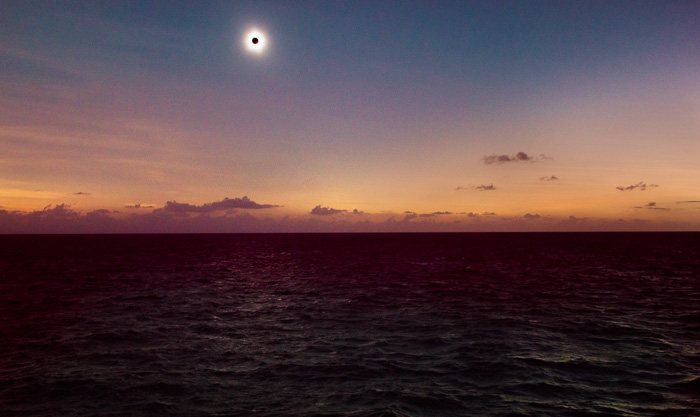I told everyone who asked that I was going to Australia for the eclipse, but the main reason for the trip to Oz was to be with friends on a boat. The reason for picking that particular boat trip was the total solar eclipse. My goal was just to see it, but, being an inveterate photographer, I planned to make a few images. But what kind of images? Thousands of photographers armed with specialized and exotic equipment have made clinically detailed photographs of the corona, of Bailey’s Beads, of any image of just the sun hanging in the sky that you can imagine. I certainly didn’t need to add more images to that pile, and I didn’t want to transport and mess with the equipment necessary to do so. I did have a mental picture of the eclipsed sun over the ocean, kind of like a sunrise or sunset. I didn’t think much more specifically than that.
As totality approached, I took the little Sony NEX-7 to the stern of the boat and got ready. When the “diamond ring” faded and the corona was all that was left, I realized that I should have planned better.
The first thing that struck me was how darned dark it was. Venus came out. So did a few bright stars. I frantically cranked up the ISO in an attempt to get a shutter speed fast enough to avoid turning the eclipse into a big blur. The next problem was contrast. The water was lit by the sky over places where the eclipse wasn’t total, but the brightest light was the corona itself. I had the prototypical photographic challenge of simultaneously making a picture of the light source and the things lit by that light source. I gave up, made a few exposures, and set aside the camera to enjoy the moment.
Here’s what I got:
I had to boost the shadow detail in the ocean quite a bit, and burn in the moon where lens flare had lightened it. All in all, a pretty weak effort. Still, I got the see the eclipse, and I am grateful for that. I’d heard people say it is an emotional experience, and I’d discounted that. I was wrong. It was amazing, and it left me speechless.
There’s another total eclipse in 2017, the first in the continental US since 1979. It will be visible in a long stripe from Oregon to South Carolina. If things work out, I’d like to see it. However, this time I’ll either automate the photography so I am not distracted by it, or maybe I’ll leave the photo gear in the bag.

Leave a Reply